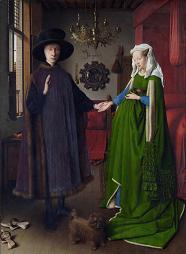Jess’s art class had all been asked to watch some TV ads the night before and to come ready to share one that had caught their eye. They also were asked to time the ads. The ads were shared and the average time worked out, along with some criteria for why these particular ads had been eye-catching.
“I wanted the students to give a painting serious, loving attention, not glance at it like an ad. I wanted them engage with the contrast between a painting and an adt. Advertisers have to get their message across in seconds, but paintings need the long gaze.

“I projected ‘The Arnolofini Marriage’ by Jan Van Eyck (http://en.wikipedia.org/wiki/File:Van_Eyck_-_Arnolfini_Portrait.jpg) for the average running time of an ad, and then I masked the screen. I asked how the painting would rank as an ad. Did anything ‘catch the eye’? Were any of the criteria from advertising present? We went on to talk about how we looked at ads and how a different type of looking was needed for paintings. We spent a long time looking at the painting, taking it in as a whole and looking at the details. We looked from a distance and close up using the zoom facility. We tried using our imaginations to explore different parts of the painting: textures, smells, tastes, sounds. We noted the effect the painting had on us. Only when we had spent time with the painting did we start to ask questions and use these to guide our research.
“After we had researched the painting, we discussed ways in which different people’s responses and our research affected how we saw the painting, and what difference it made to look at it together with others. We discussed whether the painting had a message like an ad and how we responded to it. We finished the lesson by spending time in silence looking at the painting again so that the painting had the last word.”
Jess saw her art lesson as a chance to practice looking at paintings in a way that gave them loving, respectful attention.
She engaged students by drawing on their experience (of ads) to lead them to consider a contrast, by involving their imaginations, and by giving them ways of practicing focused attention (slow examination, silence).
She reshaped her practice by choosing an opening question, providing different ways of looking at the painting, explicitly encouraging reflection on how we look at images, and attending to the structure of the lesson (the silence at the end).
It is easy for students to go through life glancing at the world, giving it superficial thought and attention. Loving attention is grounded in humility and respect, a willingness to believe that there is something worthwhile there that has escaped our first glance. This is an attitude that others deserve to be heard, and it recognizes their worth as people made in the image of God. In learning to love a piece of art, we step outside our immediate likes and dislikes and seek to give our attention to something that is important to someone else. Learning to love a piece of art (or any other work) does not have to be an emotional response; it is more of a commitment with a willingness to be challenged.
The way Jess taught this lesson made students aware of the kinds of attention encouraged by TV ads and how that could limit their engagement with other genres. It offered students concrete practice in extending their ways of viewing and challenged them to move beyond immediate likes and dislikes.
Looking and listening with loving attention could be encouraged in other subjects, for example, developing ways of reading texts that are slow and attentive.
Casual glancing can be the result of our overstimulated environment, but our own self-absorption, superficiality, and a lack of respect also can lead to paying attention. We need to cultivate a deep way of viewing the world so that we can look away from self to the object or person seen. We need to try to see things on their own terms and not just from our perspective. This is a way of viewing the world that is not centered on self.
Do you wish to be great? Then begin by being. Do you desire to construct a vast and lofty fabric? Think first about the foundations of humility. The higher your structure is to be, the deeper must be its foundation. Augustine
If we value others, we give their lives, ideas, and what they produced careful attention. A painting takes time and skill, creativity and hard work. Artists give something of themselves. Paying loving attention to what we study is a mark of respect, and that takes humility. Humility was an attitude exemplified by Jesus (Philippians 2:5).
When we pay loving attention to other people’s work, we recognise their worth. The Bible teaches that people have worth by virtue of being created by God and made in his image or likeness (Genesis 1:27). If everyone is made in God’s image, it becomes possible to learn from a wide range of people, not just Christians, though discernment is needed. All people have the potential to reflect the image of God.
Scholars differ in how they understand what being made in the image of God means; it could be our creativity, our role in bringing order in the world, or how we reflect something of God. It could be our ability to make moral decisions and our social relationships. It could be our ability to think or our ability to have a relationship with God. All these are related; the image of God cannot be reduced to one thing. The image of God is marred in humanity—like a cracked mirror. Only Jesus perfectly reflected God.
